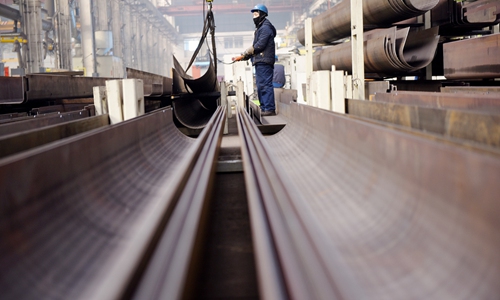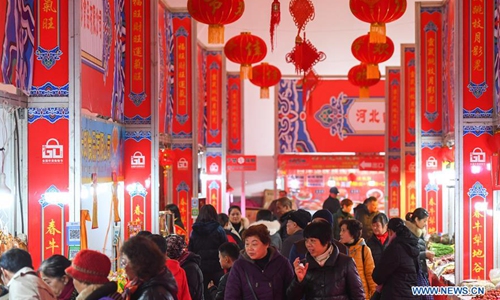January PMI neutral
Economists wary of future downward pressure from coronavirus outbreak

An employee of Chinese commercial vehicle maker FOTON works in a factory in Zhangjiakou, North China's Hebei Province on January 13. Photo: VCG
Factory activities in China's manufacturing sector remained stable in January as the purchasing managers' index (PMI) for the manufacturing sector came in at the neutral expansion/contraction threshold of 50, official data showed Friday.
The January PMI reading was slightly down from 50.2 in December, according to the National Bureau of Statistics (NBS).
The decline partly resulted from a slowdown in production growth due to the Chinese Lunar New Year holiday that reduced industrial activities, as the sub-index for production, though remaining in the expansion zone, lost 1.9 points to 51.3 in January month-on-month.
Also because of the holiday break, up to 17.6 percent of the surveyed enterprises have complained about insufficient labor supply, 2.1 percentage points higher than a month ago, said NBS senior statistician Zhao Qinghe.
Market demand for the manufacturing sector has continued to see faster expansion, as the sub-index for new orders rose 0.2 points to 51.4 in January, NBS data showed.
In January, the PMI for high-tech manufacturing, equipment manufacturing and consumer goods all stayed above 50, showing accelerated industrial transformation and upgrades, according to Zhao.
Friday's data also showed China's January composite PMI dropped marginally to 53 from 53.4 in December, indicating slower expansion in the overall production of China's companies.
The PMI for China's non-manufacturing sector rose to 54.1 in January from 53.5 in December, NBS data showed. The sub-index for business activities in the service sector reached 53.1 this month, higher than the reading of 53 in December.
The sub-reading for the non-manufacturing sector's business expectations also climbed to 59.6 in January as enterprises in the sector were increasingly optimistic about market prospects.
But Zhao noted that it would require further observations to tell future developments as the PMI surveys were carried out before January 20 when the impact of the novel coronavirus (2019-nCoV) outbreak on production activities had yet to unfold.
By the afternoon of Sunday, 14,446 confirmed cases of novel coronavirus infection had been reported in 31 provincial-level regions and the Xinjiang Production and Construction Corps, according to Chinese health authorities.
Economists are wary of future downward pressure from the novel coronavirus outbreak that hampered production and consumption activities, as the New Year holiday has been extended and people are advised to stay indoors to prevent the virus from spreading further.
Zhang Liqun, a researcher with the Development Research Center of the State Council, said as China is going through a critical period of containing the novel coronavirus outbreak, efforts must be made to ensure that economic growth remains stable amid the unprecedented complex conditions.
Wen Tao, an analyst with the China Logistics Information Center, said the ongoing outbreak would have a short-term impact on factory activities and market demand, but once the epidemic is over, the demand accumulated during this period will be fully released, leading the economy to rebound quickly.
China's GDP grew 6.1 percent year on year to 99.09 trillion yuan ($14.28 trillion) in 2019, within the government's annual target of 6 to 6.5 percent. The service sector accounted for more than half of the total economy, according to official data released earlier this month.

